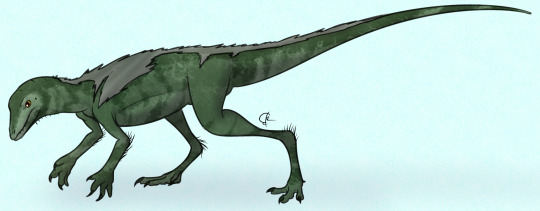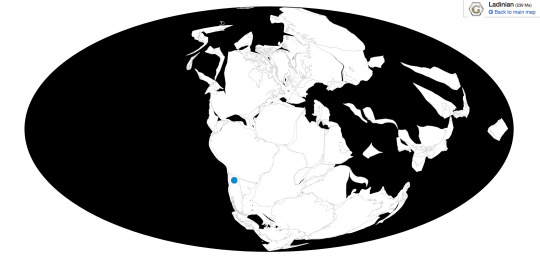#marasuchus lilloensis
Explore tagged Tumblr posts
Text
Marasuchus lilloensis

By José Carlos Cortés on @quetzalcuetzpalin-art
PLEASE SUPPORT US ON PATREON. EACH and EVERY DONATION helps to keep this blog running! Any amount, even ONE DOLLAR is APPRECIATED! IF YOU ENJOY THIS CONTENT, please CONSIDER DONATING!
Name: Marasuchus lilloensis
Name Meaning: Mara Crocodile
First Described: 1994
Described By: Sereno & Arcucci
Classification: Avemetatarsalia, Ornithodira, Dinosauromorpha, Dinosauriformes
Marasuchus is our first Dinosauriform! Dinosauriformes differed from the more early-derived Dinosauromorphs by having shortened forelimbs, and more of a hole in their hip socket, which would lead to a full hole in Dinosaurs proper that would allow for the fully-upright movement for which they are so famous. Marasuchus, however, would have been almost indistinguishable from Dinosaurs, very upright in its stature and extremely active in its lifestyle, as well as probably covered in filamentous integument.

By Michael B. H., CC BY-SA 3.0
Interestingly enough, Marasuchus didn’t have a hole in its hip socket, which may indicate a difference in lifestyle from other Dinosauriformes, though it did have other characteristics of this group such as an elongated pubis. Marasuchus lived about 236 to 234 million years ago, in Ladinian to Carnian ages of the Middle to Late Triassic. It was about 30 to 40 centimeters long and was decidedly bipedal, based on the structure of its arms and legs. It was found in the Los Chañares Formation of Argentina, known from every portion of the skeleton except for the skull.
Source:
https://en.wikipedia.org/wiki/Marasuchus
Shout out goes to @redherringjeff!
#marasuchus#marasuchus lilloensis#dinosauromorph#dinosauriform#palaeoblr#redherringjeff#dinosaur#paleontology#prehistory#prehistoric life#dinosaurs#biology#a dinosaur a day#a-dinosaur-a-day#dinosaur of the day#dinosaur-of-the-day#science#nature#factfile#דינוזאור#Dìneasar#डायनासोर#ديناصور#ডাইনোস���#risaeðla#ڈایناسور#deinosor#恐龍#恐龙#динозавр
81 notes
·
View notes
Text

A sample of Triassic terrestrial fauna, from Early to Late Triassic. From left to right: Lystrosaurus murrayi, Proterosuchus fergusi, Galesaurus planticeps, Erythrosuchus africanus, Shringasaurus indicus, Batrachotomus kupferzellensis, Dinodontosaurus turpior, Teleocrater rhadinus, Marasuchus lilloensis, Silesaurus opolensis, Hyperodapedon gordoni, Ornithosuchus woodwardi, Postosuchus kirkpatricki, Pseudochampsa ischigualastensis, Hesperosuchus agilis, Poposaurus gracilis, Blikanasaurus cromptoni, Desmatosuchus spurensis, Caelestiventus hanseni, Smilosuchus gregorii and Megazostrodon rudnerae.
#paleoart#triassic#paleoblr#paleoillustration#palaeontology#dinosaurs#palaeoblr#archosaur#therapsid#illustration#animals#palaeoart
473 notes
·
View notes
Photo




Im just going through and posting all my “Good” Paintings here to catch you all up
One to skip a few, as in skip all the paintings from my awkward transitionary period. The other paintings ive posted so far I dont think clash that hard with my current style, but if you want to see the rest, theyre here on my Deviantart account. https://kirbyniferousregret.deviantart.com/gallery/
Name: The ‘Life Sized Dinosaur’ series (Theyre not all Dinosaurs)
Animals shown: Marasuchus lilloensis, Shuvuuia deserti, Nqwebasaurus thwazi, Epidexipteryx hui, Yi qi, and Scansoriopteryx helimanni
Original Description(s): I’m not copying and pasting all that, go to my DA and read them.
Things I’d change now: Marasuchus looks rushed, Shuvuuia has too much copy pasta feathers, Nqwebasaurus has weird remiges, and Yi had a much different membrane attachment.
10 notes
·
View notes
Photo


Marasuchus lilloensis (Evolution of dinosaurs and their relatives revealed by 3D computer modelling; All models use the same limb posture- this was required to standardize comparisons.)
#transparent#cursing the gif tree#dinosaur#evolution#marasuchus lilloensis#marasuchus#dinosauromorpha#youtube#What's in John's freezer?#fruits edit
14 notes
·
View notes
Text
Lagosuchus talampayensis

By José Carlos Cortés
Etymology: Rabbit Crocodile
First Described By: Romer, 1971
Classification: Dinosauromorpha
Status: Extinct
Time and Place: About 238 million years ago, in the Ladinian age of the Middle Triassic


Lagosuchus is found in the Chañares Formation of Argentina

Physical Description: Lagosuchus was an early Dinosauromorph, aka the group that includes dinosaurs and all their closest relatives. Thus, Lagosuchus is one of many early archosaurs that showcase the origins of all dinosaurs! Lagosuchus isn’t known from particularly good remains, but it does show it was a lightly built, agile animal, which was probably bipedal and spent most of its times on its toes. At about 30 centimeters in length, it was around the size of a ferret. Its legs were amazingly long, and its toes were too, giving it good speed. It had an almost-erect posture - without the open hip sockets of dinosaurs proper, it couldn’t hold its legs directly underneath its body, but it almost could. Its forelimbs are a bit more murky, though it seems likely that Lagosuchus moved on all fours most of the time, switching to two legs when it needed to move quickly from place to place. Being an early dinosauromorph, it would have had some covering of protofeathers, though how much is a bit of question.
Diet: Lagosuchus was probably an omnivore, given the fact that early dinosaurs probably came from omnivorous origins
Behavior: Lagosuchus would have been a moderately active animal - close to a warm-blooded metabolism but not quite. As such, it probably would have spent most of its time on the move, hunting for food or searching for grubs and possibly plants it could have eaten. Lagosuchus could have used its speed to run away from predators, which were very common in its environment; and, of course, running after its own food!
It is uncertain if Lagosuchus was a social animal, or if it took care of its young; but it seems likely for the latter at least.

By Ripley Cook
Ecosystem: The Chañares Formation was a middle triassic microcosm of the explosion of evolution occurring in the Triassic, showcasing a wide variety of animals evolving in the aftermath of the Permian mass extinction. This was a low lying lake system, filled with horsetails, ferns, and some nearby conifer trees. It was also very warm, though not as warm as locations closer to the equator. There were many kinds of animals - large predatory pseudosuchians that would have hunted Lagosuchus such as Gracilisuchus, Luperosuchus, and Tarjadia; other Avemetatarsalians such as Marasuchus, Pseudolagosuchus, Lewisuchus, and Lagerpeton; the carnivorous almost-mammals Probainoganthus and Chiniquodon; the herbivorous almost-mammal Massetognathus; giant Dicynodont herbivores like Dinodontosaurus and Jachaleria; and finally the vaguely-crocodile-like Proterochampsids Gualosuchus, Chanaresuchus, and Tropidosuchus. A fascinating community indeed!
Other: Lagosuchus isn’t a particularly well known dinosauromorph; fossils assigned to it at one point that are well known, Marasuchus, have been given their own genus. It is possible that Lagosuchus is, thus, closer to dinosaurs in relationship than we think just on its own without evidence from Marasuchus. More studying of these fossils is necessary to come to better conclusions.
~ By Meig Dickson
Sources under the Cut
Arcucci, A.B. 1987. Un nuevo Lagosuchidae (Thecodontia-Pseudosuchia) de la fauna de Los Chañares (Edad Reptil Chañarense, Triasico Medio), La Rioja, Argentina. Ameghiniana 24. 89–94.
Arcucci, A., and C.A. Marsicano. 1999. A distinctive new archosaur from the Middle Triassic (Los Chañares Formation) of Argentina. Journal of Vertebrate Paleontology 19. 228–232.
Bittencourt, Jonathas S.; Andrea B. Arcucci; Claudia A. Marsicano, and Max C. Langer. 2014. Osteology of the Middle Triassic archosaur Lewisuchus admixtus Romer (Chañares Formation, Argentina), its inclusivity, and relationships amongst early dinosauromorphs. Journal of Systematic Palaeontology _. 1–31.
Fiorelli, Lucas E.; Sebastián Rocher; Agustín G. Martinelli; Martín D. Ezcurra; E. Martín Hechenleitner, and Miguel Ezpeleta. 2018. Tetrapod burrows from the Middle–Upper Triassic Chañares Formation (La Rioja, Argentina) and its palaeoecological implications. Palaeogeography, Palaeoclimatology, Palaeoecology 496. 85–102.
Jose, B. 1975. "Nuevos materiales de Lagosuchus talampayensis Romer (Thecodontia-Pseudosuchia) y su significado en el origen de los Saurischia: Chañarense inferior, Triásico medio de Argentina." Acta Geológica Lilloana. 13 (1): 5–90.
Kent, Dennis V.; Paula Santi Malnis; Carina E. Colombi; Oscar A. Alcober, and Ricardo N. Martínez. 2014. Age constraints on the dispersal of dinosaurs in the Late Triassic from magnetochronology of the Los Colorados Formation (Argentina). Proceedings of the National Academy of Sciences 111. 7958–7963.
Marsicano, C. A., R. B. Irmis, A. C. Mancuso, R. Mundil, F. Chemale. 2016. "The precise temporal calibration of dinosaur origins". Proceedings of the National Academy of Sciences of the United States of America. 113 (3): 509–513.
Nesbitt, S.J. 2011. "The Early Evolution of Archosaurs: Relationships and the Origin of Major Clades" (PDF). Bulletin of the American Museum of Natural History. 352: 189.
Romer, A. S. 1971. "The Chañares (Argentina) Triassic reptile fauna. X. Two new but incompletely known long-limbed pseudosuchians". Breviora. 378: 1–10.
Romer, A. S. 1972. "The Chañares (Argentina) Triassic reptile fauna. XV. Further remains of the thecodonts Lagerpeton and Lagosuchus". Breviora. 394: 1–7.
Palmer, D., ed. 1999. The Marshall Illustrated Encyclopedia of Dinosaurs and Prehistoric Animals. London: Marshall Editions. p. 97.
Paul, G. 1988. Predatory Dinosaurs of the World. Simon & Schuster.
Perez Loinaze, V. S., E. I. Vera, L. E. Fiorelli, J. B. Desojo. 2018. Palaeobotany and palynology of coprolites from the Late Triassic Chañares Formation of Argentina: implications for vegetation provinces and the diet of dicynodonts. Palaeogeography, Palaeoclimatology, Palaeoecology 502: 31 - 51.
Pontzer, H., V. Allen, J. R. Hutchinson. 2009. "Biomechanics of Running Indicates Endothermy in Bipedal Dinosaurs". PLoS ONE. 4 (12): e7783.
Rogers, R.R.; A.B. Arcucci; F. Abdala; P.C. Sereno; C.A. Forster, and C.L. May. 2001. Paleoenvironment and taphonomy of the Chañares Formation tetrapod assemblage (Middle Triassic), northwestern Argentina: spectacular preservation in volcanogenic concretions. Palaios 16. 461–481.
Sereno, P. C., A. B. Arcucci. 1994. "Dinosaurian precursors from the Middle Triassic of Argentina: Marasuchus lilloensis, gen. nov". Journal of Vertebrate Paleontology. 14 (1): 53–73.
#Lagosuchus#Lagosuchus talampayensis#Dinosauromorph#Prehistoric Life#Paleontology#prehistory#Outside Saurischia & Ornithischia#Triassic#South America#Omnivore#Mesozoic Monday
215 notes
·
View notes